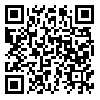Sun, Dec 21, 2025
[Archive]
Volume 12, Issue 35 (2019)
JMED 2019, 12(35): 48-54 |
Back to browse issues page
Download citation:
BibTeX | RIS | EndNote | Medlars | ProCite | Reference Manager | RefWorks
Send citation to:



BibTeX | RIS | EndNote | Medlars | ProCite | Reference Manager | RefWorks
Send citation to:
Mirzaie M, Mirzaie M, Ajam A A. Evaluation of the Relationship between Curriculum Elements and Medical Students’ Disposition Toward Critical Thinking (Case Study: Medical Students). JMED 2019; 12 (35) :48-54
URL: http://edujournal.zums.ac.ir/article-1-1158-en.html
URL: http://edujournal.zums.ac.ir/article-1-1158-en.html
1- Department of Social Sciences, Faculty of Literature, Ferdowsi University of Mashhad, Mashhad, Iran , m.mirzaie1990@mail.um.ac.ir
2- Department of Educational Sciences, Payame Noor University,Gonabad, Iran
2- Department of Educational Sciences, Payame Noor University,Gonabad, Iran
Abstract: (9896 Views)
Background & Objective: Curriculum plays an effective and determining role in realizing higher education goals and missions both qualitatively and quantitatively. Therefore, special attention paid to this area can be recognized as one of the factors effective in the improvement of efficiency and education system. Therefore, this study aimed to evaluate the relationship between curriculum elements and disposition toward critical thinking (CT).
Materials and Methods: This descriptive-correlational study was performed on 270 BSc students at Gonabad University of Medical Sciences in the academic year of 2016-2017. The subjects were selected by random stratified sampling, and two questionnaires, namely Tatar Curriculum Elements Questionnaire (2017) and Ricketts' CT Disposition Questionnaire (2003). Data analysis was performed in SPSS version 22 using Pearson’s correlation coefficient and analysis of regression.
Results: In this study, there was a significant, direct correlation between curriculum elements and disposition toward CT, and strengthening each of the curriculum elements of content (0.231), goal (0.148), method (0.307), and assessment (0.203) would be associated with the higher disposition of students toward CT. According to t-test results, no significant difference was observed between the mean score of male and female students in terms of disposition to CT (sig=0.880; t=0.151) and curriculum elements (sig=0.921, t=0.099). In addition, analysis of the regression results revealed that the sub-components of goal, content, and assessment were not significant predictors and only the variable of the method (β=0.225) made a significant prediction.
Conclusion: According to the results of the study, the curriculum elements played an essential role in strengthening students’ disposition toward CT. Therefore, it is recommended that the curriculum and its components be revised in the field of the teaching method.
Materials and Methods: This descriptive-correlational study was performed on 270 BSc students at Gonabad University of Medical Sciences in the academic year of 2016-2017. The subjects were selected by random stratified sampling, and two questionnaires, namely Tatar Curriculum Elements Questionnaire (2017) and Ricketts' CT Disposition Questionnaire (2003). Data analysis was performed in SPSS version 22 using Pearson’s correlation coefficient and analysis of regression.
Results: In this study, there was a significant, direct correlation between curriculum elements and disposition toward CT, and strengthening each of the curriculum elements of content (0.231), goal (0.148), method (0.307), and assessment (0.203) would be associated with the higher disposition of students toward CT. According to t-test results, no significant difference was observed between the mean score of male and female students in terms of disposition to CT (sig=0.880; t=0.151) and curriculum elements (sig=0.921, t=0.099). In addition, analysis of the regression results revealed that the sub-components of goal, content, and assessment were not significant predictors and only the variable of the method (β=0.225) made a significant prediction.
Conclusion: According to the results of the study, the curriculum elements played an essential role in strengthening students’ disposition toward CT. Therefore, it is recommended that the curriculum and its components be revised in the field of the teaching method.
Article Type : Orginal Research |
Subject:
Education
Received: 2019/05/1 | Accepted: 2019/11/2 | Published: 2020/03/31
Received: 2019/05/1 | Accepted: 2019/11/2 | Published: 2020/03/31
Send email to the article author
| Rights and permissions | |
 |
This work is licensed under a Creative Commons Attribution-NonCommercial 4.0 International License. |






